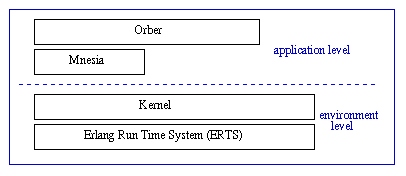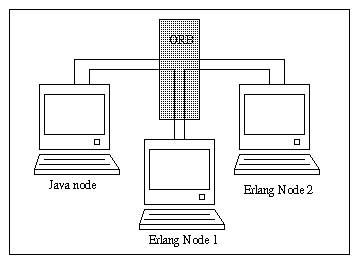2 Introduction to Orber
2.1 Overview
The Orber application is a CORBA compliant Object Request Brokers (ORB), which provides CORBA functionality in an Erlang environment. Essentially, the ORB channels communication or transactions between nodes in a heterogeneous environment.
CORBA(Common Object Request Broker Architecture) provides an interface definition language allowing efficient system integration and also supplies standard specifications for some services.
The Orber application contains the following parts:
-
ORB kernel and IIOP support
-
Interface Repository
-
Interface Definition Language Mapping for Erlang
-
CosNaming Service
Benefits
Orber provides CORBA functionality in an Erlang environment that enables:
-
Platform interoperability and transparency
Orber enables communication between OTP applications or Erlang environment applications and other platforms; for example, Windows NT, Solaris etc, allowing platform transparency. This is especially helpful in situations where there are many users with different platforms. For example, booking airline tickets would require the airline database and hundreds of travel agents (who may not have the same platform) to book seats on flights.
-
Application level interoperability and transparency
As Orber is a CORBA compliant application, its purpose is to provide interoperability and transparency on the application level. Orber simplifies the distributed system software by defining the environment as objects, which in effect, views everything as identical regardless of programming languages.
Previously, time-consuming programming was required to facilitate communication between different languages. However, with CORBA compliant Orber the Application Programmer is relieved of this task. This makes communication on an application level relatively transparent to the user.
Purpose and Dependencies
The system architecture and OTP dependencies of Orber are illustrated in figure 1 below:

Figure 2.1: Figure 1: Orber Dependencies and Structure.
Orber is dependent on Mnesia (see the Mnesia documentation) - an Erlang database management application used to store object information.
Although Orber does not have a run-time application dependency to IC (an IDLcompiler for Erlang), it is necessary when building services and applications. See the IC documentation for further details.

Figure 2.2: Figure 2: ORB interface between Java and Erlang Environment Nodes.
This simplified illustration in figure 2 demonstrates how Orber can facilitate communication in a heterogeneous environment. The Erlang Nodes running OTP and the other Node running applications written in Java can communicate via an ORB(Object Request Broker). Using Orber means that CORBA functions can be used to achieve this communication.
For example, if one of the above nodes requests an object, it does not need to know if that object is located on the same, or different, Erlang or Java nodes. The ORB will channel the information creating platform and application transparency for the user.
Prerequisites
To fully understand the concepts presented in the documentation, it is recommended that the user is familiar with distributed programming and CORBA (Common Object Request Broker Architecture).
Recommended reading includes Open Telecom Platform Documentation Set and Concurrent Programming in Erlang.
